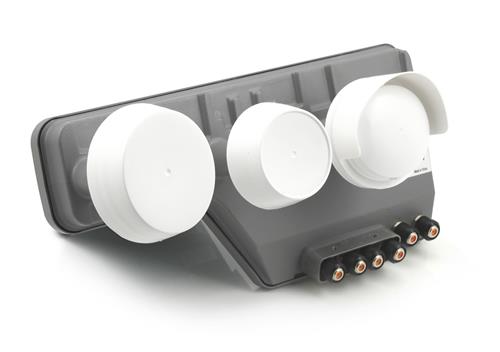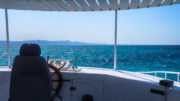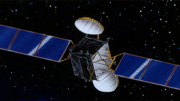This is AT&T’s Reverse Band Legacy LNB. It is flat out the most complex LNB that’s ever been produced. It receives signals from up to five satellite locations in three frequency ranges and puts out six different signals. That’s a lot for something as small and inexpensive as it is.
The Reverse Band Legacy LNB has a unique distinction of having six coaxial connectors. I don’t know of any other LNB in the world that does that, although there probably is one. Most LNBs have one or two. It’s so much cabling, so many connectors, that you can’t even fish all of them through the satellite arm. The extra two cables traditionally are zip-tied to the outside of the arm. It’s not the most elegant solution but it does work.
What do the main four cables do?
The first four cables on the LNB function much the same as they do on older LNBs. In order to understand their function it’s necessary to dig deep.
AT&T’s satellite fleet can be separated into older satellites at the 101, 110, and 119 locations and newer ones at the 99 and 103 locations. The older satellites broadcast on the Ku band. This is the frequency range traditionally associated with satellite broadcasting all over the world. The newer ones broadcast on the Ka band. AT&T is the only satellite operator with a license to use those frequencies for pay TV in North America. This allows them virtually unlimited capacity for HD and 4K transmissions.
In addition to the two different frequency ranges, AT&T separates out their signals by which transponder range they are on. One set of signals uses right-hand circular polarity, while the other uses left-hand circular polarity. Then, odd transponders end up on one cable and even transponders get on another cable. This allows for double the number of channels by making sure that each frequency range is used twice.
So, you have essentially four possible signals that can go on a cable. Ku-band odd, Ku-band even, Ka-band odd, and Ka-band even. We don’t call them that, for two reasons.
Block downconverting
The higher the frequency of a signal is, the more loss it will incur as it travels down a cable’s length. Using the signals in their native frequency range of 12,000-40,000MHz would mean they wouldn’t make it into the house. Instead, the LNB converts them down to a much more friendly range. Known as the L band, the range from 950-2150MHz is used for signals from the Ku-band satellites. Signals from the Ka-band satellite are converted down even further, to the B band at 250-500MHz. This makes it possible for the signals to travel down much longer cables.
Four different lines
With four possible frequency combinations, there needs to be a way for a receiver to select which one it wants. A combination of voltage and tone are used for this purpose.
A line carrying the signal with odd transponders will have a 13 volt current running through it. A line carrying the signal with even transponders will have an 18 volt current running through it. In this way, you can tell which signals you have by just testing the current.
Also, there are a second set of lines that have an additional “tone” (simply a modulated signal) at 22KHz. If the receiver detects this tone it knows it’s getting this second set of lines.
Both L-Band and B-Band signals exist on every combination of voltage and tone, which allows for the efficient use of the cable. It also makes it possible for DIRECTV satellite to have a truly massive number of channels using only four coax lines. This diagram tries to explain it:

Built-in multiswitch and DiSEqC
This dish, like others, has a built-in 3×4 multiswitch so any type of signal can come out of any of the four lines. This is a leftover from the 2000s when people would hook a receiver directly to the dish. Because any possible signal can be on any of the four outputs, a technology called DiSEqC is used to tell the LNB what to supply.
In a typical installation, you would simply connect any of these lines to any of the first four ports on a SWM-30 and it would “just work.” In some cases a polarity locker is used to power the dish and that also overrides the DiSEqC signals from the multiswitch and only provides one type of signal on each wire.
But what about the other two lines?
So far, it seems like this LNB functions the same as any other LNB. And for the most part it does. However, the two additional lines allow for a completely different set of signals to come in.
Called Reverse Band, this frequency range was originally only used for communication FROM the ground TO the satellite. However, it’s since been approved for communication FROM the satellite TO the ground. This roughly doubles the amount of channel capacity available to AT&T customers.
In order to receive these new signals a fifth and sixth line are used. The Reverse Band is a third frequency range, separate from the Ku band and the traditional Ka band. The Reverse Band is part of the Ka band but instead of referring to the old frequencies as Ka-Forward, they still just call them Ka and they call the new ones Reverse.
Just like the other two frequency ranges, odd transponders are separated out from even ones. However, the two additional lines do not have a multiswitch and do not use DiSEqC. Line 5 from the dish must connect to line 5 on the SWM-30. Line 6 on the dish must connect to line 6 on the SWM-30. You can’t connect a receiver of any type directly to those ports.
Other questions…
Can you use the Reverse Band LNB like a regular LNB by hooking up only four lines?
You can’t. DIRECTV systems sense what kind of LNB is in use. If the LNB does not have all lines connected, the receiver will throw up an error.
Can you use a Reverse Band LNB and SWM-30 with older, non-Genie receivers?
Yes you can. As far as I know, any receiver models H21 or higher will work with this setup. Standard definition receivers won’t work with it.
How do you aim the dish for the 5th and 6th lines?
Because the reverse band signals originate from the same satellites as the regular Ka-band signals, peaking on the regular Ka band will generally give you a very good signal on lines 5 and 6. However, you can use an AIM meter to test signal on lines 5 and 6 directly. You should note that line 6 does not accept power from the meter, so you will need to power line 5 separately while powering line 6.
How does this setup work with the international dish?
If you want to use the international dish, you can use this diplexer to connect both the international dish and line 5 from the Reverse band dish to your SWM-30. However, the Ka-band satellites now mirror all the programming from the 95 satellite location. One dish should be all you need.
How can I get help planning and implementing my system?
Over 90,000 people have downloaded our Ultimate Guide to Upgrading Your DIRECTV System, which lays out practically any possible installation. If you really want to dig deep, you should look into getting certified by the SBCA.
A word about this tutorial…
The Solid Signal Blog is your source for this and over 5,000 other tutorials. It’s also the place to find fun and interesting off-topic content. But, it doesn’t happen by accident. This site is 100% funded by our parent site, SolidSignal.com. Solid Signal is your source for everything you’ll ever need for your DIRECTV installation, and tons of free tech support. I hope you’ll visit Solid Signal and shop for everything you need to make your DIRECTV project a success.





